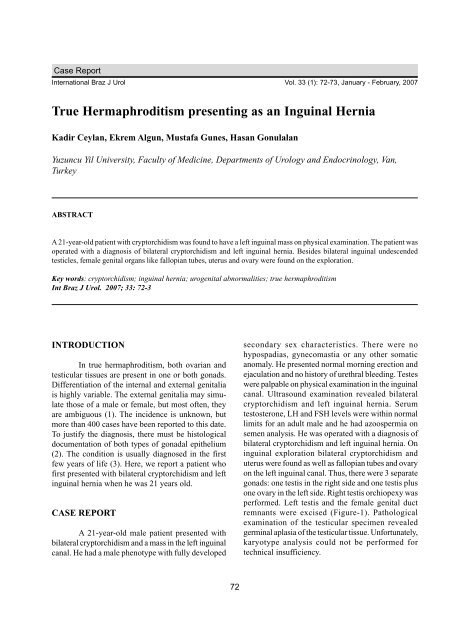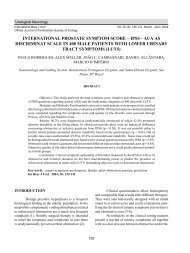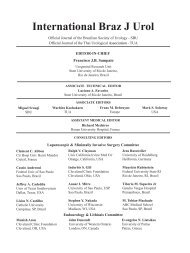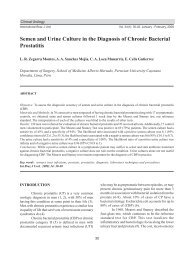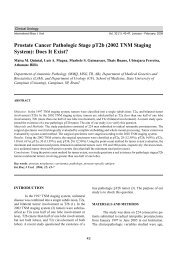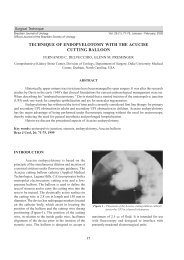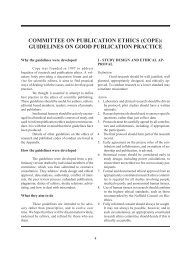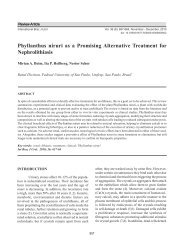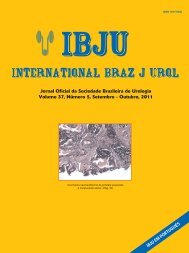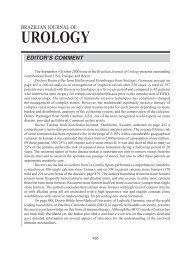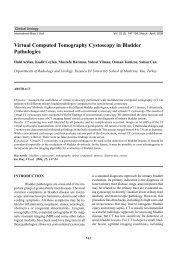True Hermaphroditism presenting as an Inguinal Hernia - SciELO
True Hermaphroditism presenting as an Inguinal Hernia - SciELO
True Hermaphroditism presenting as an Inguinal Hernia - SciELO
You also want an ePaper? Increase the reach of your titles
YUMPU automatically turns print PDFs into web optimized ePapers that Google loves.
C<strong>as</strong>e Report<br />
<strong>True</strong> <strong>Hermaphroditism</strong> <strong>presenting</strong> <strong>as</strong> <strong>an</strong> <strong>Inguinal</strong> <strong>Hernia</strong><br />
International Braz J Urol Vol. 33 (1): 72-73, J<strong>an</strong>uary - February, 2007<br />
<strong>True</strong> <strong>Hermaphroditism</strong> <strong>presenting</strong> <strong>as</strong> <strong>an</strong> <strong>Inguinal</strong> <strong>Hernia</strong><br />
Kadir Ceyl<strong>an</strong>, Ekrem Algun, Mustafa Gunes, H<strong>as</strong><strong>an</strong> Gonulal<strong>an</strong><br />
Yuzuncu Yil University, Faculty of Medicine, Departments of Urology <strong>an</strong>d Endocrinology, V<strong>an</strong>,<br />
Turkey<br />
ABSTRACT<br />
A 21-year-old patient with cryptorchidism w<strong>as</strong> found to have a left inguinal m<strong>as</strong>s on physical examination. The patient w<strong>as</strong><br />
operated with a diagnosis of bilateral cryptorchidism <strong>an</strong>d left inguinal hernia. Besides bilateral inguinal undescended<br />
testicles, female genital org<strong>an</strong>s like fallopi<strong>an</strong> tubes, uterus <strong>an</strong>d ovary were found on the exploration.<br />
Key words: cryptorchidism; inguinal hernia; urogenital abnormalities; true hermaphroditism<br />
Int Braz J Urol. 2007; 33: 72-3<br />
INTRODUCTION<br />
In true hermaphroditism, both ovari<strong>an</strong> <strong>an</strong>d<br />
testicular tissues are present in one or both gonads.<br />
Differentiation of the internal <strong>an</strong>d external genitalia<br />
is highly variable. The external genitalia may simulate<br />
those of a male or female, but most often, they<br />
are ambiguous (1). The incidence is unknown, but<br />
more th<strong>an</strong> 400 c<strong>as</strong>es have been reported to this date.<br />
To justify the diagnosis, there must be histological<br />
documentation of both types of gonadal epithelium<br />
(2). The condition is usually diagnosed in the first<br />
few years of life (3). Here, we report a patient who<br />
first presented with bilateral cryptorchidism <strong>an</strong>d left<br />
inguinal hernia when he w<strong>as</strong> 21 years old.<br />
CASE REPORT<br />
A 21-year-old male patient presented with<br />
bilateral cryptorchidism <strong>an</strong>d a m<strong>as</strong>s in the left inguinal<br />
c<strong>an</strong>al. He had a male phenotype with fully developed<br />
secondary sex characteristics. There were no<br />
hypospadi<strong>as</strong>, gynecom<strong>as</strong>tia or <strong>an</strong>y other somatic<br />
<strong>an</strong>omaly. He presented normal morning erection <strong>an</strong>d<br />
ejaculation <strong>an</strong>d no history of urethral bleeding. Testes<br />
were palpable on physical examination in the inguinal<br />
c<strong>an</strong>al. Ultr<strong>as</strong>ound examination revealed bilateral<br />
cryptorchidism <strong>an</strong>d left inguinal hernia. Serum<br />
testosterone, LH <strong>an</strong>d FSH levels were within normal<br />
limits for <strong>an</strong> adult male <strong>an</strong>d he had azoospermia on<br />
semen <strong>an</strong>alysis. He w<strong>as</strong> operated with a diagnosis of<br />
bilateral cryptorchidism <strong>an</strong>d left inguinal hernia. On<br />
inguinal exploration bilateral cryptorchidism <strong>an</strong>d<br />
uterus were found <strong>as</strong> well <strong>as</strong> fallopi<strong>an</strong> tubes <strong>an</strong>d ovary<br />
on the left inguinal c<strong>an</strong>al. Thus, there were 3 separate<br />
gonads: one testis in the right side <strong>an</strong>d one testis plus<br />
one ovary in the left side. Right testis orchiopexy w<strong>as</strong><br />
performed. Left testis <strong>an</strong>d the female genital duct<br />
remn<strong>an</strong>ts were excised (Figure-1). Pathological<br />
examination of the testicular specimen revealed<br />
germinal apl<strong>as</strong>ia of the testicular tissue. Unfortunately,<br />
karyotype <strong>an</strong>alysis could not be performed for<br />
technical insufficiency.<br />
72
<strong>True</strong> <strong>Hermaphroditism</strong> <strong>presenting</strong> <strong>as</strong> <strong>an</strong> <strong>Inguinal</strong> <strong>Hernia</strong><br />
<strong>True</strong> hermaphroditism should also be<br />
considered in the differential diagnosis of<br />
cryptorchidism <strong>an</strong>d inguinal hernia in a patient in the<br />
second or third decade.<br />
CONFLICT OF INTEREST<br />
None declared.<br />
REFERENCES<br />
Figure 1 – Intraoperative view of the female genital duct<br />
remn<strong>an</strong>ts, ovary <strong>an</strong>d testis.<br />
COMMENTS<br />
<strong>True</strong> hermaphroditism is a phenotypically <strong>an</strong>d<br />
genetically <strong>an</strong> heterogeneous condition. Gonadal<br />
tissue may be located at <strong>an</strong>y level along the route of<br />
embryonic testicular descent <strong>an</strong>d is frequently<br />
<strong>as</strong>sociated with <strong>an</strong> inguinal hernia. There may be<br />
unilateral or bilateral ovotestis or a testis on one side<br />
<strong>an</strong>d ovary on the other side. A uterus is usually present,<br />
though it may be hypopl<strong>as</strong>tic or unicornous (1-4). Our<br />
c<strong>as</strong>e had testis on the right side <strong>an</strong>d a testis <strong>an</strong>d female<br />
genital structures on the left side. Ovari<strong>an</strong> tissue w<strong>as</strong><br />
dysgenetic <strong>an</strong>d testicular tissue showed germinal<br />
apl<strong>as</strong>ia.<br />
In true hermaphroditism, the degree of<br />
virilisation of the external genitalia depends on the<br />
capacity of testicular tissue to secrete testosterone <strong>an</strong>d<br />
the presence or absence of a uterus <strong>an</strong>d tubes.<br />
Although approximately 70% of true hermaphrodites<br />
are raised <strong>as</strong> males, less th<strong>an</strong> 10% have normal male<br />
external genitalia (1,2). Our c<strong>as</strong>e had completely<br />
normal external genitalia except for cryptorchidism,<br />
moreover, the patient had fully developed secondary<br />
sexual characteristics <strong>an</strong>d defined erections <strong>an</strong>d<br />
ejaculations.<br />
Most of the true hermaphrodites have<br />
ambiguous genitalia <strong>an</strong>d are diagnosed in the first few<br />
months to years of their life (3). Our c<strong>as</strong>e is unique<br />
because there is no diagnosis during the first 21 years<br />
of his life.<br />
1. Conte FA, Grumbach MM: Abnormalities of Sexual<br />
Determination <strong>an</strong>d Differentiation. In: T<strong>an</strong>agho EA,<br />
McAninch JW (eds.), Smith’s General Urology.<br />
International Edition, 15th ed., New York, McGraw-<br />
Hill. 2000; pp. 699-736.<br />
2. Griffin JE, Wilson JD: Disorders of Sexual<br />
Differentiation. In: Walsh PC, Retik BA, Stamey TA,<br />
Vaugh<strong>an</strong> DE (eds.), Campbell’s Urology. Philadelphia,<br />
WB Saunders. 1992; pp. 1509-42.<br />
3. Hadjiath<strong>an</strong><strong>as</strong>iou CG, Brauner R, Lortat-Jacob S, Nivot<br />
S, Jaubert F, Fellous M, et al.: <strong>True</strong> hermaphroditism:<br />
genetic vari<strong>an</strong>ts <strong>an</strong>d clinical m<strong>an</strong>agement. J Pediatr.<br />
1994; 125: 738-44.<br />
4. Diamond DA: Sexual Differentiation: Normal <strong>an</strong>d<br />
Abnormal. In: Walsh PC, Retik BA, Vaugh<strong>an</strong> DE, Wein<br />
AJ (eds.), Campbell’s Urology. Philadelphia, WB<br />
Saunders. 2002; pp. 2395-427.<br />
Correspondence address:<br />
Dr. Kadir Ceyl<strong>an</strong><br />
Yüzüncü Yil Universitesi<br />
Tip Fakültesi<br />
Uroloji Anabilim Dali<br />
V<strong>an</strong>, Turkey<br />
E-mail: drceyl<strong>an</strong>26@yahoo.com<br />
Accepted after revision:<br />
October 15, 2006<br />
73


